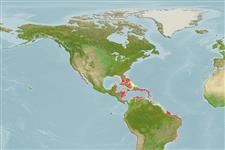Common names from other countries
>
Eupercaria/misc (Various families in series Eupercaria) >
Scaridae (Parrotfishes) > Sparisomatinae
Etymology: Sparisoma: Latin, sparus = a fish with a golden head + Greek, soma = body (Ref. 45335).
More on author: Valenciennes.
Environment: milieu / climate zone / depth range / distribution range
Ecología
marino asociado a arrecife; rango de profundidad 1 - 12 m (Ref. 9710). Tropical; 33°N - 30°S, 89°W - 31°W
Western Atlantic: Bermuda, Florida (USA), Bahamas, and eastern Gulf of Mexico through central America to Santa Catarina, Brazil (Ref. 57756).
Tamaño / Peso / Age
Maturity: Lm ? range ? - ? cm
Max length : 20.0 cm TL macho / no sexado; (Ref. 7251); common length : 15.0 cm TL macho / no sexado; (Ref. 5217)
Espinas dorsales (total) : 9; Radios blandos dorsales (total) : 10; Espinas anales: 3; Radios blandos anales: 9. Front of upper jaw has horizontal canine-like tusks. 2 scales between bases of pelvic fins (Ref. 26938). Drab-phase fish are olivaceous to yellowish brow, finely speckled with pale dots, many are conjoined; base and axil of pectoral fins broadly blue-green. Terminal-phase males are greenish brown with faint pale dots, some scales with reddish edges; irregular orange-red markings on opercle; a blackish bar at pectoral base; a broad blackish border posteriorly on caudal fin (Ref. 13442).
Mostly found in seagrass beds in shallow, protected waters. Feeds primarily on epiphytes and seagrass blades, leaving crescent bite marks. Darts into seagrass when frightened (Ref. 9710).
Life cycle and mating behavior
Maturities | Reproducción | Spawnings | Egg(s) | Fecundities | Larva
Robins, C.R. and G.C. Ray, 1986. A field guide to Atlantic coast fishes of North America. Houghton Mifflin Company, Boston, U.S.A. 354 p. (Ref. 7251)
IUCN Red List Status (Ref. 130435)
CITES (Ref. 128078)
Not Evaluated
Threat to humans
Reports of ciguatera poisoning (Ref. 30303)
Human uses
Can't connect to MySQL database (fbapp). Errorcode: Too many connections
